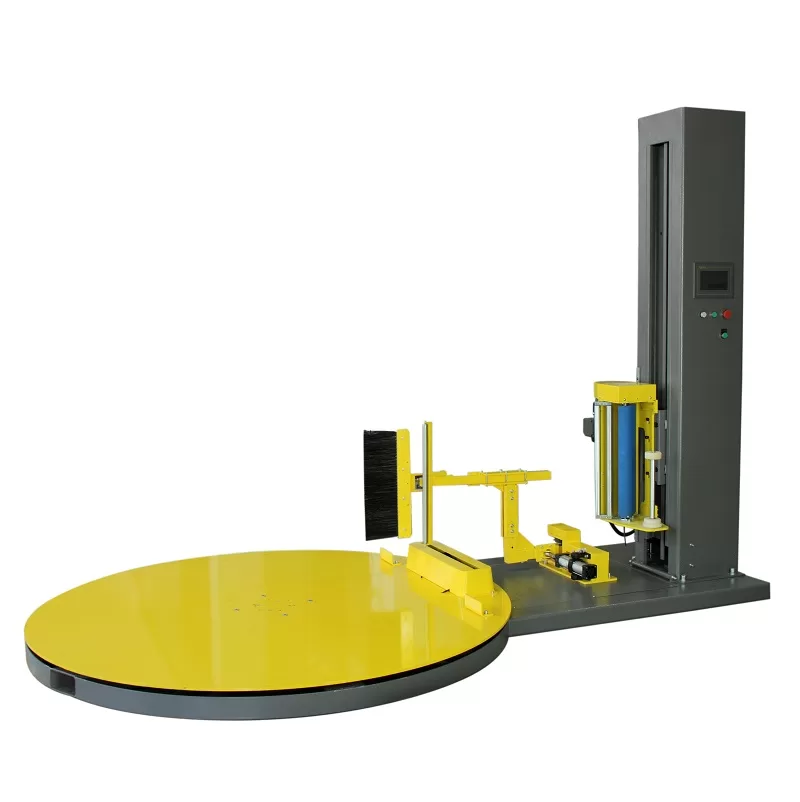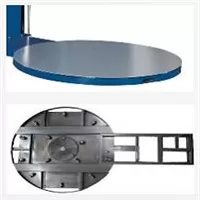Understanding Pallet Stretch Wrapper Operation and Technology
In modern manufacturing and logistics, ensuring palletized goods are secure and protected during handling, storage, and transit is paramount. The pallet stretch wrapper, a cornerstone of industrial packaging equipment, automates the application of stretch film, providing load stability and protection efficiently. This guide delves into the operation, types, features, and benefits of these essential machines, crucial for streamlining packaging operations and maintaining product integrity.
Visualizing the process can clarify the machine's function. Below is a demonstration of a typical pallet stretch wrapper in operation:
How Pallet Stretch Wrappers Work
At its core, a pallet stretch wrapper applies stretch film tightly around a loaded pallet. The two primary methods involve:
- Turntable Wrappers: The pallet load is placed on a rotating platform. As the turntable spins, a film delivery system moves vertically up and down a mast, dispensing the stretch film around the load.
- Rotary Arm Wrappers: The pallet load remains stationary, while an overhead arm holding the film delivery system rotates around the load. This method is often preferred for very heavy, light, or unstable loads.
Key components typically include the turntable or rotary arm, a mast, a film carriage (which houses the film roll and often includes a pre-stretch mechanism), and a control system (ranging from simple buttons to sophisticated PLCs with touch screens).
Types of Pallet Stretch Wrappers
Stretch wrappers are generally categorized by their level of automation:
- Manual Stretch Wrappers: Require an operator to manually attach the film, guide the wrapping process (often with a hand-held dispenser), and cut the film. These are suitable for very low volume operations.
- Semi-Automatic Stretch Wrappers: Automate the film application process but require an operator to place the pallet on the machine, attach the film tail to the load, initiate the wrap cycle via controls, and cut the film upon completion. The machine controls the wrap pattern, film tension, and number of wraps.
- Automatic Stretch Wrappers: Integrate fully into automated production lines. They automatically convey pallets into the wrap zone, apply the film, cut and seal the film tail, and discharge the wrapped pallet without operator intervention. These offer the highest throughput.
Key Features and Technical Specifications
While specific parameters vary significantly by model, manufacturer, and intended application, common features and specifications to consider when evaluating a pallet stretch wrapper include:
- Max Pallet Size: Defines the maximum length and width of the pallet the machine can handle (e.g., 1200mm L x 1200mm W).
- Max Wrap Height: Determined by the mast height, indicating the tallest load the machine can wrap.
- Load Capacity: The maximum weight the turntable or conveyor system can support (e.g., up to 2000kg).
- Wrapping Speed: Measured in pallets per hour (e.g., up to 35 PPH for some automatic models), influencing throughput.
- Film Delivery System: Critical for performance and film economy. Key aspects include:
- Pre-stretch: Mechanisms that stretch the film before application (e.g., 150% to 300%). Higher pre-stretch significantly reduces film consumption and cost.
- Film Cut and Clamp: Automatic systems often feature mechanisms to automatically cut the film tail and clamp it for the next cycle.
- Control System: Ranges from basic controls to programmable logic controllers (PLCs) with user-friendly touch screen interfaces allowing customization of wrap patterns, top/bottom wraps, film tension, and turntable/arm speed.
- Turntable/Rotary Arm Speed: Adjustable speed (e.g., up to 15 RPM) allows optimization for load stability and wrap quality.
- Power Requirements: Standard industrial power needs (e.g., 240V/480V, 60Hz, single or three-phase).
- Machine Dimensions & Weight: Physical footprint and weight (e.g., 2500mm L x 1500mm W x 2500mm H; approx. 690kg).
- Safety Features: Essential elements like emergency stop buttons, safety fences or light curtains, sensors to detect obstructions, and audible alarms.
- Film Type Compatibility: Typically designed for Linear Low-Density Polyethylene (LLDPE) stretch film of various gauges.

pallet stretch wrap 1 Benefits of Using Pallet Stretch Wrappers
Implementing a pallet stretch wrapper offers significant operational and financial advantages:
- Load Stability and Security: Provides consistent containment force, unifying the load and securing it to the pallet, significantly reducing product damage during transit.
- Protection from Elements: Shields goods from dust, dirt, moisture, and UV radiation (with specific film types).
- Improved Efficiency and Throughput: Automating the wrapping process is significantly faster and more consistent than manual wrapping, increasing packaging line speed.
- Reduced Material Costs: Pre-stretch capabilities maximize film yield, cutting down on consumable costs compared to manual wrapping or lower-spec machines.
- Enhanced Workplace Safety: Reduces the physical strain and potential injuries associated with manual wrapping. Automated systems minimize operator interaction during the wrapping cycle.
- Improved Professional Appearance: Consistently wrapped pallets present a more professional image to customers.
Common Applications Across Industries
Pallet stretch wrappers are versatile machines utilized in nearly every industry that ships palletized goods:
Logistics and Distribution Centers
Essential for preparing diverse pallet loads for shipment, ensuring stability for LTL (Less Than Truckload) and FTL (Full Truckload) carriers. High-speed automatic wrappers are common in high-volume DCs.
Food and Beverage Manufacturing
Used extensively to wrap cases of beverages, canned goods, bagged items, and other food products. Stretch wrapping helps maintain cleanliness, protects against contamination, and secures multi-unit loads.
Chemical and Pharmaceutical Industries
Provides crucial protection for drums, sacks, or boxes containing powders, granules, or liquids. Wrapping prevents spills, contamination, and moisture ingress, supporting regulatory compliance for handling certain materials.
Building Materials
Secures loads of bricks, tiles, cement bags, insulation, and other construction materials, preventing shifting and damage during rough handling common in this sector.
Consumer Goods Manufacturing
Wraps pallets of electronics, appliances, paper products, textiles, and other finished goods, protecting them from dust, scuffs, and moisture during warehousing and final distribution.
Operational Considerations and Safety
Proper operation and maintenance are key to maximizing the benefits and lifespan of a pallet stretch wrapper:
- Operator Training: Ensure personnel are adequately trained on machine operation, safety procedures, film threading, and basic troubleshooting.
- Proper Loading: Pallets should be centered correctly on the turntable or within the wrap zone to ensure even wrapping.
- Film Settings: Adjust film tension, pre-stretch levels, and wrap patterns based on the specific load characteristics (weight, height, stability, product type) for optimal containment and minimal film usage. Consider using different types of stretch film for varying needs.
- Routine Maintenance: Follow the manufacturer's recommendations for cleaning, lubrication, and inspection of components like rollers, chains, belts, and sensors.
- Safety Protocols: Always adhere to safety guidelines, utilize emergency stops when necessary, and ensure safety guards or sensors are functional. Refer to resources like OSHA guidelines or MHI standards for broader industrial safety practices.

pallet stretch wrap 3 Conclusion
In conclusion, the pallet stretch wrapper is an indispensable tool in modern packaging lines and logistics operations. Whether employing a semi-automatic unit for moderate throughput or a fully automatic system integrated into a high-speed line, these machines deliver substantial improvements in load security, product protection, operational efficiency, and material cost savings. Understanding the different types, key features, and operational best practices allows businesses to select and utilize stretch wrapping technology effectively, safeguarding products from the plant floor to their final destination.
